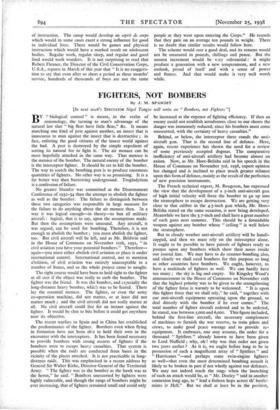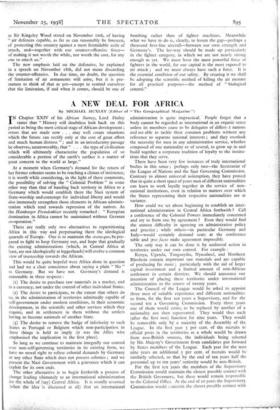FIGHTERS, NOT BOMBERS
By J. M. SPAIGHT
[In next week's SPECTATOR Nigel Tangye will write on " Bombers, not Fighters "1 BY " biological control " is meant, in the realm of entomology, the turning to man's advantage of the is a confession of failure.
No greater blunder was committed at the Disarmament Conference of 1932-34 than the attempt to abolish the fighter as well as the bomber. The failure to distinguish between these two categories was responsible in large measure for the failure to do anything about the air menace then. In a way it was logical enough—in theory—to ban all military aircraft : logical,. that, is to say, upon the assumptions made. But then the assumptions were unsound. Any aircraft, it was argued, can be used for bombing. Therefore, it is not enough to abolish the bomber ; you must abolish the fighter, too. But civil aircraft will be left, and as Mr. Baldwin said in the House of Commons on November loth, 1932, " in civil aviation you have your potential bombers." Therefore- again—you must either abolish civil aviation or place it under international control. International control, not to mention abolition, of civil aviation was entirely unacceptable to a number of States, and so the whole project came to naught.
The right course would have been to hold tight to the fighter at all cost if the object was really to curb the bomber. The fighter was the friend. It was the bomber, and especially the long-distance heavy bomber, which was to be feared. There lay the essential menace. The fighter, or even the army co-operation machine, did not matter, or at least did not matter much ; and the civil aircraft did not really matter at all. No civil aircraft could live for an instant against the fighter. It would be shot to bits before it could get anywhere near its objective.
The recent warfare in Spain and in China has established the predominance of the fighter. Bombers even when flying in formation have not been ab:e to hold their own in the encounter with the interceptors. It has been found necessary to provide bombers with strong escorts of fighters if the bombers were to escape heavy casualties. That system is possible when the raids are conducted from bases in. the vicinity of the places attacked. It is not practicable in long- distance raids. This was emphasised in a recent address by General Sir Walter Kirke, Director-General of the Territorial Army. " The fighter was to the bomber as the hawk was to the heron," he said. " Bombers unescorted by fighters were highly vulnerable, and though the range of bombers might be ever increasing, that of fighters remained small and could only be increased at the expense of fighting efficiency. If then an enemy could not establish aerodromes close to our shores the danger was immensely reduced, since his bombers must come unescorted, with the certainty of heavy casualties."
Behind, or below, the interceptor there stands the anti- aircraft gun. That is the second line of defence. Here, again, recent experience has shown the need for a review of some previously accepted dogmas. The comparative inefficiency of anti-aircraft artillery had become almost an axiom. Now, as Mr. Hore-Belisha said in his speech in the House of Commons on November 3rd, 1938, expert opinion has changed and is inclined to place much greater reliance upon this form of defence, mainly as the result of the perfection of new precision instruments.
The French technical expert, M. Rougeron, has expressed the view that the' development of a "5-inch anti-aircraft gun of high initial velocity will force the bomber to go up into the stratosphere to escape destruction. We are getting very close to that calibre in the 4.5-inch gun which, Mr. Hore- Belisha stated on the same occasion, is now being developed. Meanwhile we have the 3.7-inch and shall have a great number of such guns next summer. This should be a formidable weapon against any bomber whose " ceiling " is well below the stratosphere.
But in cloudy weather anti-aircraft artillery will be handi- capped, and then we must rely on the interceptor alone. It ought to be possible to have patrols of fighters ready to pounce upon any bombers which show their noses inside our Coastal line. We may have to do counter-bombing also, and clearly we shall need bombers for this purpose so long as other countries have bombers. We ought, however, to have a multitude of fighterS as well. We can hardly have too many ; the sky is big and empty. Sir Kingsley Wood's announcement in the House of Commons on November loth that the highest priority was to be given to the strengthening of the fighter force is warmly to be welcomed. " It is upon this fighter force that we shall rely," he said, " together with our anti-aircraft equipment operating upon the ground, to deal directly with the bomber if he ever comes." The total number of fighter aircraft ordered and to be ordered, he stated, was between 5,000 and 6,000. This figure included, behind the first-line aircraft, the necessary complement of machines to furnish the war reserve, to train pilots and crews, to make good peace wastage and to provide re- equipment. It embraces, one may assume, the order for a thousand " Spitfires " already known to have been given to Lord Nuffield ; why, oh ! why was that order not given two years earlier ? As it is, we ought before long to be in possession of such a magnificent array of " Spitfires " and " Hurricanes "—and perhaps some twin-engine fighters as well—that even the most determined bombing assault is likely to be broken in part if not wholly against our defences. We may not indeed reach the stage when the 'launching of such an attack would be, as " Mr. Dooley " said in another connexion long ago, to " lead a forlorn hope acrost th' battle- mints iv Hell." But we shall at Jeast be in the position, as Sir-Kingsley Wood stated on November loth, of having " air' defences capable, as far as can reasonably be foreseen, of protecting this country against a most formidable scale of attack, and—together with our counter-offensive force— of making it not worth the while, nor worth the cost, for any one to attack us."
The new emphasis laid on the defensive, he explained in a speech on November 18th, did not mean discarding the counter-offensive. In due time, no doubt, the question of limitation of air armaments will arise, but it is pre- mature to think of that as yet—except to remind ourselves that the limitation, if and when it comes, should be one of bombing rather than of fighter machines. Meanwhile what we have to do is, clearly, to lessen the gap—perhaps a thousand first-line aircraft—between our own strength and Germany's. The lee-way should be made up particularly in the fighter category, in which we are not nearly strong enough as yet. We must have the most powerful force of fighters in the world, for our capital is the most exposed to air attack ; and we must always have such a force. It is the essential condition of our safety. By creating it we shall be adopting the scientific method of killing the air menace for all practical purposes—the method of " biological control."















































 Previous page
Previous page